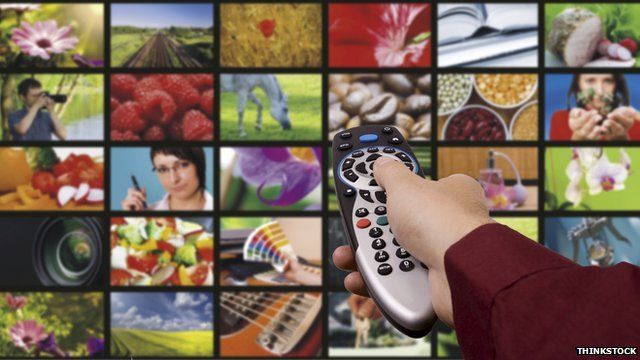Netflix and Amazon: A brave new on-demand TV world
- Published

I used to think that TV was in a slow death spiral. Now I think its best days are yet to come.
Here's why:
MORE COMPLEX DRAMAS
The new ways of consuming TV on demand and via the internet mean we can have richer, denser, more complex dramas.
When TV channel controllers decided what we got to watch and when we got to watch it, they would typically schedule shows once a week.
The original British version of House of Cards was in four parts, each an hour, run on successive Sunday nights in late 1990. This was about as ambitious as an episodic developing drama could be.
Schedulers knew that if viewers had missed the first episode then they were unlikely to join a drama on episode two or three, therefore the potential audience for a mini-series declined as the weeks went on.
In the past, the people who commissioned longer running dramas would hedge their bets by insisting that each episode could be digested as a self-contained show. On demand has changed that.
Watch David Grossman's Newsnight film in full
The Netflix version of House of Cards is 13 episodes (plus another 13 in the second season). Each is intricate, even novelistic, in its character and plot development.
As a result it would be pretty baffling to join halfway through, but, of course, no-one has to.
"Ten years ago," says the head of Amazon Studios, Roy Price, "you might miss episode two and episode four because you were out to dinner those nights.
"But once the schedule is yours to determine, because it's on demand, I think people are less likely to miss some of those intervening episodes.
"That means from a television point of view each episode doesn't have to be completely standalone, so it does change how you can tell the story."
MORE POWER TO WRITERS
TV provided on demand should mean we can move away from "lowest common denominator" scheduling.
Traditionally, linear channel controllers would pitch their offering to maximise the available audience.
They would do this by making sure they commissioned something that 80% of people thought was OK.
In a linear channel world, such a show might be a big "hit" because it was regarded as just about preferable to whatever else was on at the time.
In an on-demand world that sort of programme just won't survive.
According to Mr Price "every show now has to be somebody's favourite show".
This takes power away from TV executives and gives it to the writers and creators.
"We have to create an environment where artistic vision can come out," he says.
"It's not about me telling people how to make a TV show, it's about finding people like Jill Soloway who have a very specific, compelling vision that can attract a passionate audience, because they are passionate themselves about creating something new and terrific."
Soloway has a long list of writing credits including funeral parlour drama series Six Feet Under.
I met her in Hollywood where she was filming her new series for Amazon, Transparent, a warm, funny drama about a transgender father coming out to his family.
It's clearly not to everyone's taste, but the point is that it doesn't have to be.
"We have so little of the typical network interference that you would normally see," she tells me.
"Normally there would be 15 or 20 people here on the set giving notes on every performance, generally about their fear about what might not work."
CROWD-SOURCED COMMISSIONING
Another change from the way traditional TV works is the way Transparent was commissioned. It was one of 10 pilot shows that Amazon offered to its subscribers.
On the basis of how many people watched it and their comments, the full series was given the green light.
This method, you could call it crowdsourced commissioning, allows TV companies to concentrate resources on what people want to watch.
The TV companies will have access to huge amounts of data about what we are watching, giving them far more insight into what we actually watch (rather than what we say we watch)
NEW FORMS OF TV
The current way TV is packaged, divided into hours and half-hours and series (or as we now call them "seasons"), is a product of the linear channel age.
Online delivery opens the way for exploring new forms of TV.
Binge-watching an entire series in one or two sittings is pretty commonplace with on demand TV, but there's no reason why we can't have single shows lasting 12 or even 24 hours that viewers either ration out over weeks, or gorge in one long session.
And with all that data to guide them, don't be surprised if the TV companies are able to present the same show differently depending on who is watching.
Of course, all of this depends on customers having access to fast enough broadband and the TV companies being able to pump their content around unrestricted by the internet service providers.
- Published5 June 2014
- Published21 May 2014
- Published21 April 2014
- Published21 April 2014
- Published21 April 2014